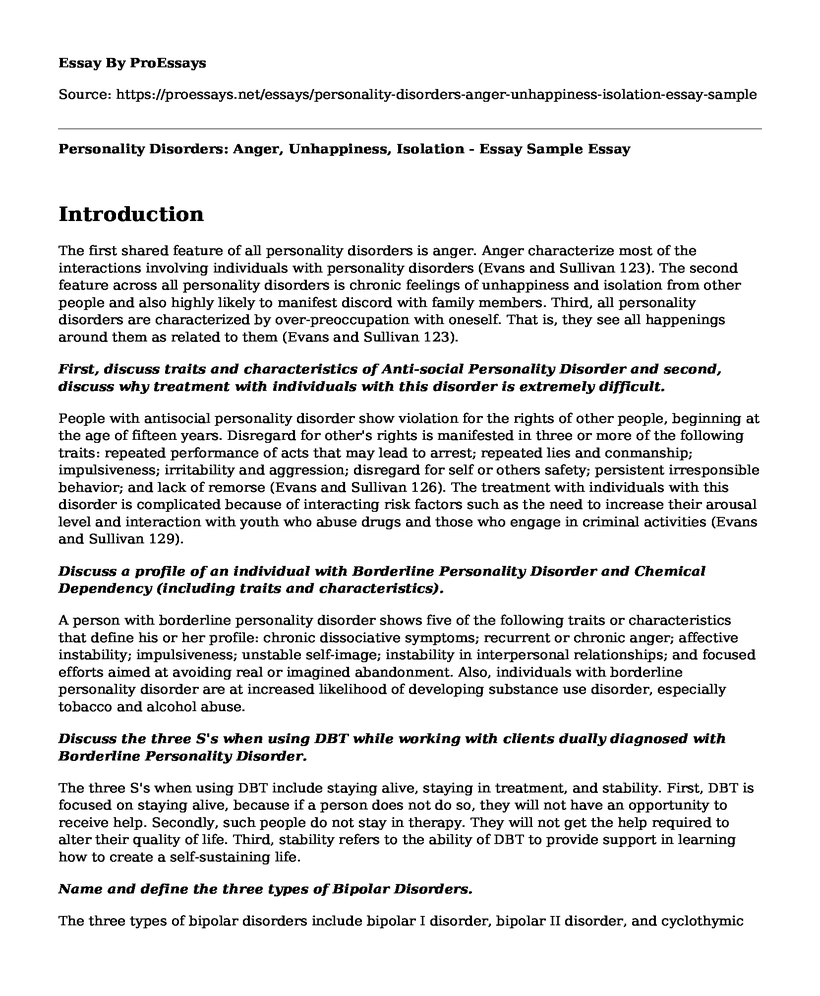Introduction
The first shared feature of all personality disorders is anger. Anger characterize most of the interactions involving individuals with personality disorders (Evans and Sullivan 123). The second feature across all personality disorders is chronic feelings of unhappiness and isolation from other people and also highly likely to manifest discord with family members. Third, all personality disorders are characterized by over-preoccupation with oneself. That is, they see all happenings around them as related to them (Evans and Sullivan 123).
First, discuss traits and characteristics of Anti-social Personality Disorder and second, discuss why treatment with individuals with this disorder is extremely difficult.
People with antisocial personality disorder show violation for the rights of other people, beginning at the age of fifteen years. Disregard for other's rights is manifested in three or more of the following traits: repeated performance of acts that may lead to arrest; repeated lies and conmanship; impulsiveness; irritability and aggression; disregard for self or others safety; persistent irresponsible behavior; and lack of remorse (Evans and Sullivan 126). The treatment with individuals with this disorder is complicated because of interacting risk factors such as the need to increase their arousal level and interaction with youth who abuse drugs and those who engage in criminal activities (Evans and Sullivan 129).
Discuss a profile of an individual with Borderline Personality Disorder and Chemical Dependency (including traits and characteristics).
A person with borderline personality disorder shows five of the following traits or characteristics that define his or her profile: chronic dissociative symptoms; recurrent or chronic anger; affective instability; impulsiveness; unstable self-image; instability in interpersonal relationships; and focused efforts aimed at avoiding real or imagined abandonment. Also, individuals with borderline personality disorder are at increased likelihood of developing substance use disorder, especially tobacco and alcohol abuse.
Discuss the three S's when using DBT while working with clients dually diagnosed with Borderline Personality Disorder.
The three S's when using DBT include staying alive, staying in treatment, and stability. First, DBT is focused on staying alive, because if a person does not do so, they will not have an opportunity to receive help. Secondly, such people do not stay in therapy. They will not get the help required to alter their quality of life. Third, stability refers to the ability of DBT to provide support in learning how to create a self-sustaining life.
Name and define the three types of Bipolar Disorders.
The three types of bipolar disorders include bipolar I disorder, bipolar II disorder, and cyclothymic disorder. Bipolar I disorder is manifested through severe mood disorders such as mania and depression. Secondly, bipolar II disorder is characterized by a mild form of elevated moods alternating with depression. Third, the cyclothymic disorder is characterized by short periods of hypomanic symptoms which alternate with brief duration of depressive episodes.
Describe a manic episode and a depressive episode of Bipolar Disorder.
A manic episode is characterized by feelings of elevated euphoria, creativity, and energy. On the other hand, a depressive episode is characterized by episodes of depression with diverse attributes such as the presence of manic and depressive symptoms.
Define the two types of Depressive (Unipolar) Mood (Affective) Disorders.
Examples of depressive (unipolar) mood (affective) disorders include anxiety disorder and bipolar disorder. Anxiety disorder is characterized by fear or worries about future events. On the other hand, bipolar disorder is characterized by extreme mood swings.
Define the following three Anxiety Disorders: Social Phobia, Obsessive-Compulsive Disorder, Post-Traumatic Stress Disorder.
Social phobia is a type of disorder characterized by significant worry and self-consciousness because of the fear of being evaluated by other people. On the other hand, obsessive-compulsive disorder is an anxiety disorder characterized by the recurrence of annoying thoughts or obsessions that make an individual feel driven to engage in an activity repeatedly. Lastly, post-traumatic stress disorder is an anxiety disorder caused by experience or an encounter of a terrifying event.
Name the symptoms that most individuals with Anxiety Disorders share.
Anxiety disorders are characterized by nausea, dry mouth, heart palpitations, shortness of breath, and sleep problems.
Works Cited
Evans, Katie, and J. Michael Sullivan. Dual Diagnosis, Second Edition: Counseling the Mentally Ill Substance Abuser. Guilford Press, 2012.
Cite this page
Personality Disorders: Anger, Unhappiness, Isolation - Essay Sample. (2023, Mar 17). Retrieved from https://proessays.net/essays/personality-disorders-anger-unhappiness-isolation-essay-sample
If you are the original author of this essay and no longer wish to have it published on the ProEssays website, please click below to request its removal:
- Happiness and the Virtues According to Aristotle
- A Reflection Paper: Thirteen Reasons Why
- Maslow Hierarchy of Needs, McGregor Theory and Herzberg Two Factor Theory
- Essay Example on Adolescence: Transitional Stage to Adulthood
- Deep Listening: A Path to Stress Relief - Essay Sample
- Essay Sample on Daydreaming Effects on Mental Health
- Impact of New ADHD Treatments - Free Essay Sample







